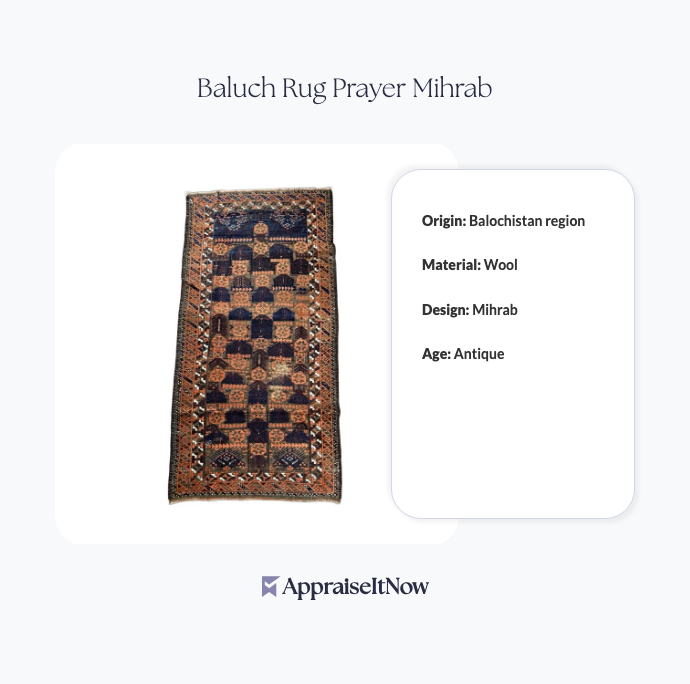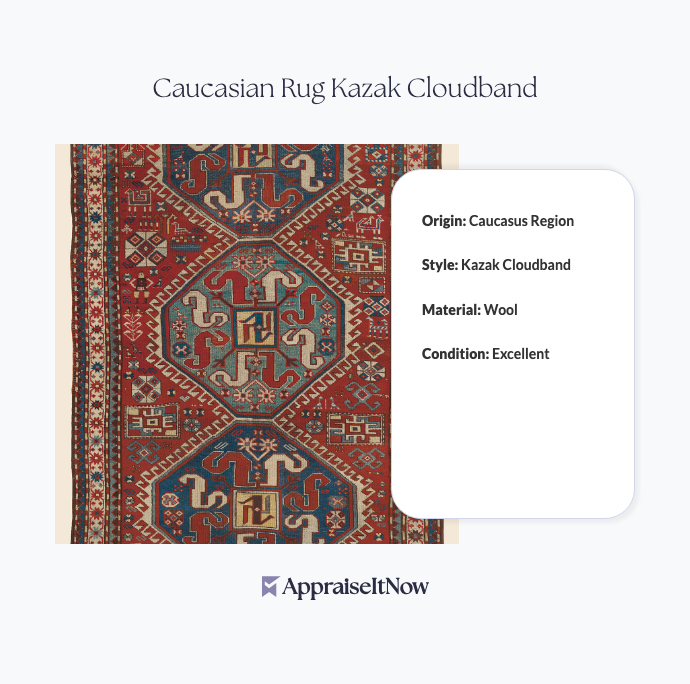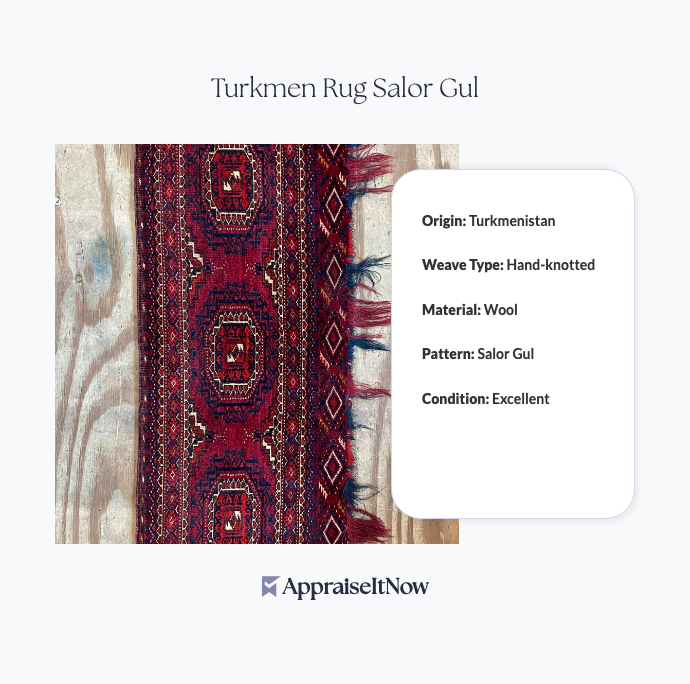<h1>How to Get Your Baluch Rug Prayer Mihrab Appraised</h1>
<p>A Baluch rug prayer mihrab isn't just a decorative textile—it's a piece of cultural heritage with real monetary value. Whether you've inherited one, discovered it at an estate sale, or are considering a purchase, getting a professional appraisal helps you understand what your rug is actually worth. These handwoven pieces typically range from <strong>$3,000 to $5,000</strong>, but determining your specific rug's value requires expertise and careful evaluation.</p>
<h2>Understanding Baluch Rug Prayer Mihrab Value</h2>
<p>The Baluch rug prayer mihrab represents a sophisticated intersection of artistry, cultural significance, and historical craftsmanship. Produced by the Baluch people—a nomadic ethnic group spanning Balochistan across Pakistan, Iran, and Afghanistan—these rugs were traditionally created with profound intention. The mihrab design, featuring a stylized prayer niche or arch, isn't merely decorative; it served a religious purpose, orienting worshippers during Islamic prayer ceremonies and creating a sacred space within the home.</p>
<p>What makes your rug's valuation complex is that monetary worth extends beyond physical condition into cultural importance. When evaluating whether your rug is worth money, professionals examine the intricacy of design, vibrancy and authenticity of natural dyes, quality of wool, and the rug's age and provenance. A prayer mihrab featuring particularly intricate geometric patterns or exceptional color preservation can command prices at or above the upper range of typical valuations.</p>
<div class="callout tip"><p><strong>Valuation Insight</strong></p>
<p>Baluch prayer rugs with documented provenance from specific artisan communities or regions often command 15-25% premiums over similar pieces without origin documentation.</p></div>
<h2>Key Characteristics That Determine Your Rug's Worth</h2>
<p>Understanding what appraisers look for when examining a Baluch rug prayer mihrab helps you prepare for a professional evaluation. These textiles carry distinctive hallmarks that either confirm authenticity or reveal later reproductions—a critical distinction affecting value.</p>
<p><strong>Age and Historical Context</strong> form the foundation of valuation. Baluch rugs were first introduced in the 19th century, and pieces from that era command significantly higher values than 20th-century examples. When trying to identify how old a rug is, specialists examine weaving techniques, dye chemistry, and wear patterns. Original natural dyes—derived from plant and mineral sources—create color palettes that synthetic dyes simply cannot replicate. An appraiser can often determine authenticity by examining the back of the rug, where dye absorption patterns reveal whether colors are natural or synthetic.</p>
<p>The <strong>geometric patterns and design complexity</strong> vary considerably among Baluch prayer rugs. The most valuable examples feature intricate repeating patterns surrounding the central mihrab, creating visual depth and demonstrating the weaver's technical skill. Simpler geometric designs appear in less valuable pieces, though this doesn't diminish cultural significance—it merely reflects market demand among collectors.</p>
<p><strong>Wool quality and density</strong> significantly impact longevity and value. High-quality Baluch rugs use closely-knotted wool from sheep adapted to the Balochistan region, creating durable fabrics that age gracefully. An appraiser will examine knot density—measured in knots per square inch—as a key indicator of craftsmanship and materials quality. This metric directly correlates with both durability and market value.</p>
<h2>How to Identify an Authentic Prayer Rug</h2>
<p>One of the most common questions collectors ask is how to identify a genuine prayer rug versus modern reproductions. The prayer rug's defining feature—the mihrab or prayer arch—should appear naturally integrated into the overall design rather than awkwardly imposed. Genuine Baluch prayer rugs feature the mihrab as the design's focal point, with the geometric patterns flowing organically around this central element.</p>
<p>When examining a potential purchase or evaluating what you own, look for specific visual markers. The mihrab typically occupies approximately one-third of the rug's length, creating a natural proportional relationship with surrounding pattern work. Authentic prayer rugs display slight variations in pattern repetition—a hallmark of hand-weaving that distinguishes them from modern machine-made alternatives. This human inconsistency, paradoxically, confirms authenticity and increases value rather than diminishing it.</p>
<p>Exploring how to tell if a rug is vintage involves examining fiber condition and color aging patterns. Over decades, natural dyes develop rich patina through exposure to light and air. This mellowing process creates unique color combinations that distinguish vintage pieces from newly-created reproductions. When evaluating your rug's age, a specialist considers color harmony as evidence of time's passage and authenticity.</p>
<div class="callout note"><p><strong>Authenticity Check</strong></p>
<p>Flip the rug over and examine the knots from underneath. Natural knot irregularities and inconsistencies are hallmarks of authentic hand-weaving, while perfectly uniform knots often indicate machine production or recent reproduction.</p></div>
<h2>Understanding Your Rug's Market Position</h2>
<p>The Baluch rug prayer mihrab occupies a distinct market segment within the broader textile collecting world. These pieces are more accessible than high-end Persian rugs—which can command six or seven figures—yet represent significant investments compared to mass-produced contemporary area rugs. Understanding which Persian rugs are the most valuable helps contextualize your Baluch piece within the broader textile hierarchy.</p>
<p>Your prayer mihrab sits above generic decorative rugs but below museum-quality Persian masterworks. This positioning makes them particularly attractive to collectors seeking authentic cultural artifacts without purchasing prices that rival fine art. The cultural significance of these textiles has increased in recent years as collectors recognize their importance to Islamic artistic traditions and nomadic heritage.</p>
<p>The question of whether Persian rugs are increasing in value applies directly to Baluch pieces. Genuine antique examples have shown consistent appreciation, particularly as awareness of nomadic textile traditions grows among international collectors. Well-preserved vintage pieces from the early 20th century or earlier demonstrate stronger appreciation than more recent examples, making age documentation particularly valuable for appraisal purposes.</p>
<h2>Condition Assessment and Value Impact</h2>
<p>Your Baluch rug's physical condition directly influences its market value—sometimes dramatically. A piece showing minimal wear with rich, undamaged colors commands premium pricing, while rugs with significant fading, staining, or structural damage may fall toward the lower end of the valuation range. Professional appraisers evaluate condition using standardized criteria that clearly document these variations for insurance and sale purposes.</p>
<p>Common condition issues include color fading from light exposure, moth or insect damage to fibers, staining from spills or age-related oxidation, and pile flattening from foot traffic. Some issues are reversible through professional conservation, while others represent permanent alterations to the textile. Understanding these distinctions helps establish realistic valuations and guides decisions about restoration versus preservation.</p>
<p>A prayer rug with active damage—such as spreading tears, unraveling edges, or active pest infestation—requires immediate professional attention. Conservation specialists can often restore these textiles to stable condition, potentially recovering 30-50% of the value lost to deterioration. This is why professional appraisal serves purposes beyond simple valuation; it identifies preservation needs that protect your investment.</p>
<h2>Navigating the Appraisal Process for Textiles</h2>
<p>Getting your Baluch rug prayer mihrab professionally appraised involves more than casual inspection. Specialists in tribal and nomadic textiles, like those found through AppraiseItNow, examine your rug using standardized protocols that document every relevant characteristic. Understanding what to expect helps you prepare appropriate materials and questions for your appraiser.</p>
<p>The appraisal process typically begins with comprehensive photography from multiple angles, including close-ups of the mihrab design, knot structure, and any damage or wear patterns. Your appraiser will measure the rug precisely, document fiber composition, and assess overall condition. They'll research comparable sales of similar Baluch prayer rugs to establish fair market value based on current collector demand and recent transaction data.</p>
<p>When selecting an appraiser, look for credentials in appraising fine textiles and antique rugs. Professional appraisers hold certifications from organizations like the American Society of Appraisers (ASA) or International Society of Appraisers (ISA), and they provide USPAP-compliant reports suitable for insurance, estate planning, or sale purposes. Our detailed guide on <a href="/blog/appraising-fine-textiles-valuing-antique-fabrics-and-weavings">appraising fine textiles and antique fabrics</a> offers comprehensive insights into what specialists evaluate during the assessment process.</p>
<h2>Practical Steps for Selling or Insuring Your Rug</h2>
<p>Whether you're selling your prayer mihrab or need insurance documentation, a certified appraisal establishes the foundation for all subsequent transactions. For insurance purposes, you need an agreed-value appraisal that documents replacement cost should your rug be damaged or stolen. This documentation typically costs significantly less than the rug itself while protecting your investment against unforeseen loss.</p>
<p>If you're considering selling, understanding your rug's documented value through professional appraisal strengthens your negotiating position. Collectors and dealers respect certified valuations from qualified experts far more than owner estimates. An appraisal report provides the credibility and documentation that serious buyers expect, often resulting in faster sales at more favorable prices. For guidance on the broader <a href="/blog/appraising-tribal-rugs-and-textiles-exploring-artistic-traditions-and-techniques">process of appraising tribal rugs and textiles</a>, explore how specialists evaluate these culturally significant pieces.</p>
<p>You might wonder whether it's legal to sell Persian rugs in the U.S.—the answer is yes, provided they're imported legally and don't violate cultural patrimony laws. Your appraisal documentation, combined with clear provenance showing legitimate ownership history, ensures compliance with regulations and facilitates hassle-free transactions. International collectors particularly value this documentation when purchasing from U.S. sellers.</p>
<div class="callout tip"><p><strong>Pro Tip</strong></p>
<p>Maintain detailed documentation of your rug's condition, care, and any professional conservation work performed. This record substantially enhances appraisal value and provides essential information for future owners or insurers.</p></div>
<h2>Understanding Price Variations and Market Factors</h2>
<p>The difference between paying $3,000 versus $5,000 for a comparable Baluch rug prayer mihrab reflects nuanced variations in condition, age, design complexity, and provenance. When determining how much to pay for a rug, experienced collectors examine these specific factors rather than relying on generic "antique rug" pricing. A 19th-century example with exceptional color preservation and intricate geometric patterning might justify $4,500-$5,000, while a 1960s piece with modest wear might appraise at $3,000-$3,500.</p>
<p>Knowing how to estimate the value of a rug involves understanding these layered considerations. Age matters significantly, but condition and design quality often override age in determining final valuations. A well-preserved 1930s rug might command higher prices than a damaged 1890s piece, illustrating why professional evaluation considers multiple factors rather than applying simplistic age-based formulas.</p>
<p>The cultural significance of these textiles has grown considerably among serious collectors, particularly those interested in Islamic art traditions and nomadic heritage. This expanding collector base has supported steady appreciation in Baluch textile values over the past two decades. Unlike some antiques that experience cyclical market enthusiasm, genuine Baluch prayer rugs maintain relatively stable value supported by enduring cultural and historical interest.</p>
<h2>Distinguishing Your Prayer Mihrab from Other Rugs</h2>
<p>A common source of confusion involves differentiating between Persian rugs and Baluch prayer rugs. While Baluch rugs are created by an ethnic group traditionally associated with the broader Persian cultural sphere, they represent a distinct tradition with different aesthetic principles and market positioning. The difference between a Persian rug and a Persian carpet is primarily dimensional—carpets exceed approximately 6 by 9 feet, while rugs fall below that threshold—but Baluch pieces typically fall into the rug category.</p>
<p>Prayer rugs specifically feature the mihrab design, which immediately distinguishes them from secular decorative rugs. This religious design element adds cultural significance that collectors recognize and value. Understanding this distinction helps when estimating your rug's relative worth compared to similar-sized or similar-aged rugs without prayer elements.</p>
<p>Exploring the role of regional styles in textile appraisals illuminates why Baluch pieces have distinctive characteristics. The nomadic traditions of the Baluch people, combined with their geographic location spanning multiple nations, created a unique aesthetic incorporating influences from Persian, Afghan, and Pakistani textile traditions. This cultural blending makes Baluch prayer rugs intellectually fascinating while creating specialized collector markets that appreciate these distinctions.</p>
<h2>Beyond Monetary Value: Cultural and Historical Significance</h2>
<p>While establishing your Baluch rug prayer mihrab's market value remains the primary appraisal purpose, understanding its broader significance enriches appreciation for this textile. These rugs represent living cultural traditions that have persisted for centuries despite significant geopolitical challenges. The craft traditions embedded in each hand-knotted piece connect contemporary owners to generations of weavers who maintained these skills despite pressures toward modernization.</p>
<p>The research on evaluating cultural significance of art appraisals extends beyond monetary assessment to encompass historical importance and cultural heritage preservation. Museums and institutional collectors increasingly recognize Baluch textiles as important documentation of nomadic artistic traditions. This institutional interest, combined with growing Western collector demand, positions these pieces as both cultural artifacts and valuable investments.</p>
<p>For collectors interested in the broader context of tribal art and textiles, exploring how specialists approach appraising tribal art reveals the sophisticated frameworks that recognize cultural significance alongside market value. This perspective helps frame your rug not merely as a decorative object but as a tangible connection to specific cultural traditions and historical moments.</p>
<div class="callout note"><p><strong>Key Takeaway</strong></p>
<p>A professional appraisal of your Baluch rug prayer mihrab provides essential documentation for insurance, estate planning, or sale purposes, while connecting you to expert knowledge about this important cultural textile. Whether your rug appraises at $3,000 or $5,000, certified valuation ensures you understand both its monetary worth and its place within broader traditions of Islamic and nomadic artistic heritage.</p></div>







.avif)







